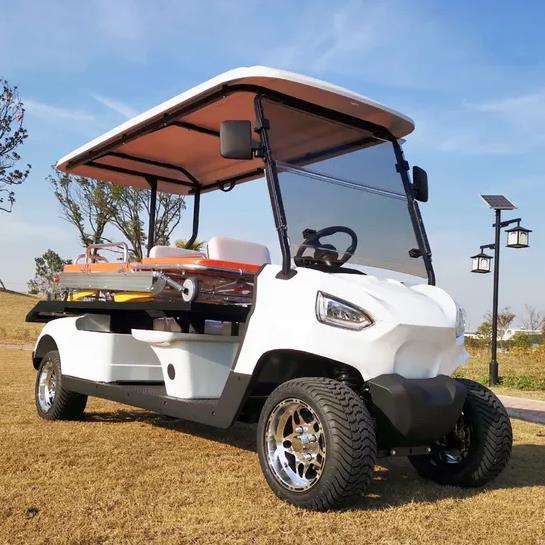Content Menu
● Understanding Electric Ambulance Carts
>> Key Features of Electric Ambulance Carts
● Advantages of Electric Vehicles in Emergency Services
>> Benefits of Electric Vehicles
● Comparative Analysis: Electric Ambulance Carts vs. Electric Vehicles
>> Use Cases for Each Option
● Challenges Facing Electric Ambulance Carts and Vehicles
>> Common Challenges
● Future Trends in Emergency Services
● Case Studies and Real-World Applications
>> London's Electric Ambulance Initiative
>> Hospital-Based Electric Carts
● Technological Advancements and Innovations
>> Advanced Battery Systems
>> Smart City Integration
● Global Adoption and Policy Support
>> Policy Incentives
>> Environmental Regulations
● Conclusion
● FAQ
>> 1. What are the primary benefits of using electric ambulance carts?
>> 2. How do full-sized electric ambulances compare to traditional ambulances?
>> 3. What challenges do electric vehicles face in emergency services?
>> 4. Are there any advancements expected in electric ambulance technology?
>> 5. Can electric ambulances operate effectively during emergencies?
The integration of electric vehicles into emergency services is a significant advancement in the field of healthcare transportation. As cities grow and environmental concerns rise, the need for efficient, sustainable emergency response solutions has become paramount. This article explores the practicality of electric ambulance carts compared to traditional electric vehicles (EVs) in emergency services, examining their features, benefits, challenges, and future potential.

Understanding Electric Ambulance Carts
Electric ambulance carts are specialized vehicles designed for emergency medical services, particularly in environments where traditional ambulances may struggle to navigate. These carts are powered by electric motors and are often used in settings like hospitals, resorts, and urban areas with narrow streets.
Key Features of Electric Ambulance Carts
- Zero Emissions: Electric ambulance carts produce no tailpipe emissions, making them environmentally friendly options that help reduce urban air pollution.
- Compact Design: Their smaller size allows for easy maneuverability in tight spaces, making them ideal for quick patient transport within crowded areas like hospitals or events.
- Low Noise Operation: The silent operation of these carts minimizes noise pollution, which is particularly beneficial in residential areas and during nighttime emergencies.
- Cost-Effective Maintenance: With fewer moving parts than traditional ambulances, electric ambulance carts typically incur lower maintenance costs.
- Advanced Medical Equipment Integration: Many models are equipped with storage for medical supplies and devices, ensuring that paramedics can provide immediate care during transport.
Advantages of Electric Vehicles in Emergency Services
Electric vehicles, including full-sized ambulances converted to electric power, offer a range of benefits that enhance emergency response capabilities.
Benefits of Electric Vehicles
- Faster Response Times: Electric vehicles provide rapid acceleration and instant torque, allowing emergency responders to reach the scene quickly.
- Lower Operating Costs: The cost per mile for electricity is significantly lower than that of gasoline or diesel fuel. For instance, operating an electric ambulance can cost around 7p per mile compared to 27p for a diesel equivalent.
- Reduced Environmental Impact: Like electric ambulance carts, full-sized electric ambulances contribute to cleaner air by eliminating exhaust emissions.
- Enhanced Patient Comfort: The quiet operation allows paramedics to communicate effectively with patients and operate sensitive medical equipment without disturbance.
Comparative Analysis: Electric Ambulance Carts vs. Electric Vehicles
To evaluate the practicality of each option for emergency services, we can compare their features side by side:
| Feature | Electric Ambulance Cart | Full-Sized Electric Vehicle |
| Size | Compact | Larger |
| Maneuverability | High | Moderate |
| Speed/Acceleration | Moderate | High |
| Noise Level | Very Low | Low |
| Environmental Impact | Zero Emissions | Zero Emissions |
| Cost Efficiency | Lower Maintenance Costs | Lower Operating Costs |
| Patient Care Equipment | Limited Integration | Extensive Integration |
| Ideal Use Cases | Urban Areas, Hospitals | Broader Emergency Response |
Use Cases for Each Option
1. Electric Ambulance Carts
- Ideal for transporting patients within hospital grounds or at events where space is limited.
- Useful in facilities like airports or large resorts where quick access to medical care is needed without the bulk of a full-sized vehicle.
2. Full-Sized Electric Vehicles
- Suitable for long-distance transport between healthcare facilities.
- Effective in urban settings where speed and range are critical for emergency response.

Challenges Facing Electric Ambulance Carts and Vehicles
While both electric ambulance carts and full-sized electric vehicles present numerous advantages, they also face challenges that must be addressed to enhance their practicality in emergency services.
Common Challenges
- Range Anxiety: Both types of vehicles can experience limitations in range compared to traditional fuel-powered ambulances. However, advancements in battery technology are gradually improving this aspect.
- Charging Infrastructure: The availability of charging stations remains a concern, particularly in rural areas where access may be limited. Establishing a robust charging network is essential for the successful deployment of electric vehicles in emergency services.
- Initial Investment Costs: The upfront costs associated with purchasing electric vehicles or carts can be higher than traditional options. However, long-term savings on fuel and maintenance can offset these initial expenses.
Future Trends in Emergency Services
The future of emergency medical transportation is likely to see continued advancements in both electric ambulance carts and full-sized electric vehicles. Key trends include:
- Integration of Autonomous Technology: As autonomous driving technology matures, it may be possible to deploy self-driving electric ambulances that can navigate traffic more efficiently without human intervention.
- Smart Charging Solutions: Innovations in charging technology could lead to faster charging times and more efficient use of energy resources during peak demand periods.
- Sustainability Initiatives: Governments and organizations are increasingly prioritizing sustainability efforts, leading to investments in greener technologies within emergency services.
Case Studies and Real-World Applications
Several cities and healthcare organizations have already begun integrating electric vehicles into their emergency services. For example, some hospitals use electric carts for internal patient transport, while cities like London have introduced electric ambulances for urban emergency responses. These real-world applications demonstrate the feasibility and effectiveness of electric solutions in diverse settings.
London's Electric Ambulance Initiative
London's introduction of electric ambulances marks a significant step towards reducing emissions and improving response times in urban environments. These ambulances are designed to handle the demands of city streets while minimizing environmental impact.
Hospital-Based Electric Carts
In many hospitals, electric carts are used for transporting patients between departments. This not only reduces noise levels but also ensures that patients receive timely medical attention without the need for larger vehicles.
Technological Advancements and Innovations
Technological advancements play a crucial role in enhancing the capabilities of electric ambulances. Innovations such as advanced battery systems, improved charging infrastructure, and integration with smart city technologies are expected to further increase the efficiency and practicality of electric emergency vehicles.
Advanced Battery Systems
Advancements in battery technology are crucial for extending the range and reducing the charging time of electric ambulances. New battery materials and designs are being developed to meet these needs, ensuring that electric vehicles can perform effectively in emergency situations.
Smart City Integration
The integration of electric ambulances with smart city infrastructure can enhance emergency response times by optimizing traffic flow and providing real-time traffic updates. This integration also facilitates the efficient allocation of emergency resources.
Global Adoption and Policy Support
Global adoption of electric vehicles in emergency services is gaining momentum, driven by policy support and environmental regulations. Governments worldwide are implementing incentives and mandates to encourage the transition to electric vehicles, recognizing their potential to reduce emissions and improve public health.
Policy Incentives
Many countries offer tax incentives, subsidies, or preferential parking for electric vehicles, which can help offset the higher initial costs of purchasing electric ambulances. These incentives are crucial for encouraging healthcare providers to adopt sustainable transportation solutions.
Environmental Regulations
Stricter environmental regulations are pushing emergency services to adopt cleaner technologies. For instance, cities with low-emission zones are increasingly requiring emergency vehicles to meet specific emissions standards, making electric options more appealing.
Conclusion
In conclusion, both electric ambulance carts and full-sized electric vehicles offer unique advantages that make them practical options for modern emergency services. While electric ambulance carts excel in maneuverability and noise reduction within confined spaces like hospitals or events, full-sized electric vehicles provide broader capabilities for long-distance transport and rapid response. As technology continues to advance and infrastructure improves, the integration of these electric solutions will likely play a crucial role in enhancing the efficiency and sustainability of emergency medical services worldwide.

FAQ
1. What are the primary benefits of using electric ambulance carts?
Electric ambulance carts offer zero emissions, low noise operation, compact design for maneuverability, cost-effective maintenance, and integration with advanced medical equipment.
2. How do full-sized electric ambulances compare to traditional ambulances?
Full-sized electric ambulances provide faster response times due to rapid acceleration, lower operating costs from electricity use, reduced environmental impact with zero emissions, and enhanced patient comfort from quieter operation.
3. What challenges do electric vehicles face in emergency services?
Challenges include range anxiety due to limited battery life compared to fuel-powered vehicles, the need for adequate charging infrastructure, and higher initial investment costs despite lower long-term operational expenses.
4. Are there any advancements expected in electric ambulance technology?
Yes, advancements such as autonomous driving technology integration and smart charging solutions are expected to enhance the efficiency and practicality of electric ambulances in the future.
5. Can electric ambulances operate effectively during emergencies?
Yes, electric ambulances have been shown to perform effectively during emergencies with quick response times and reliable operation under various conditions while also providing a quieter environment for patient care.










































